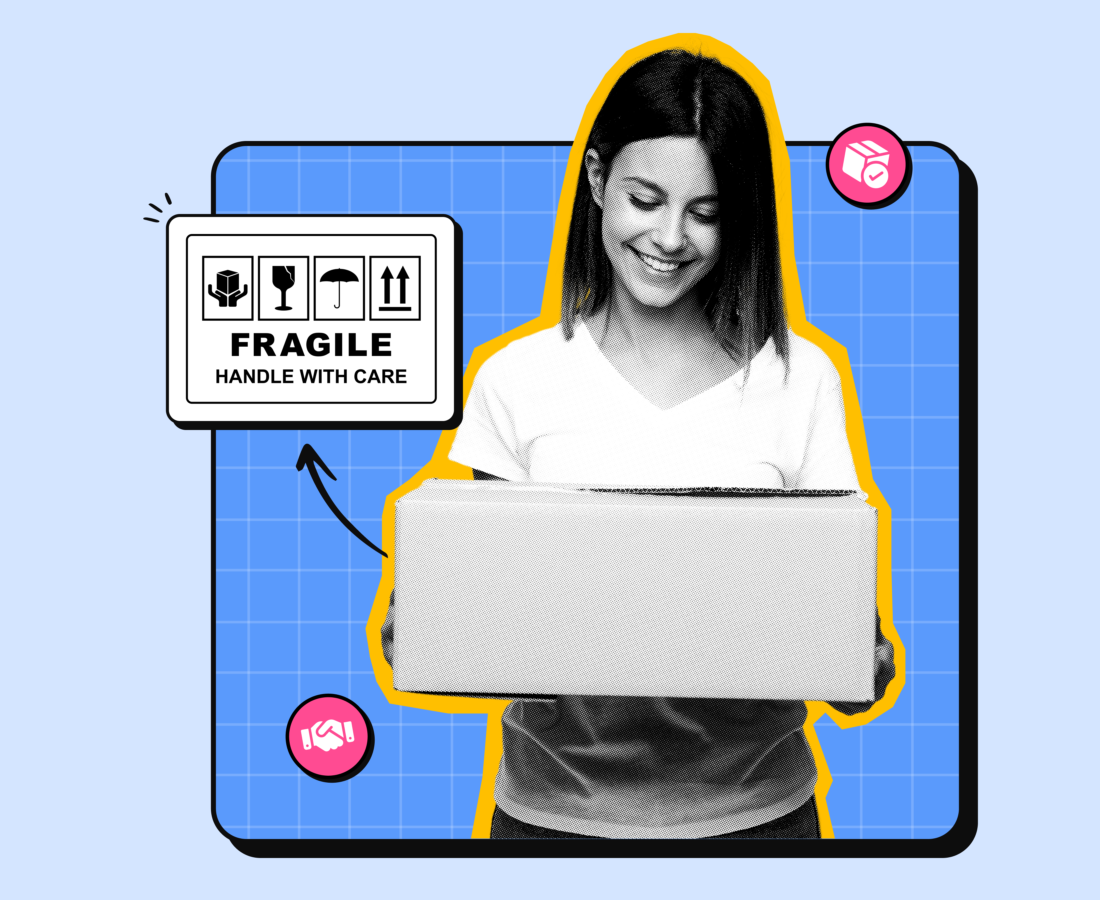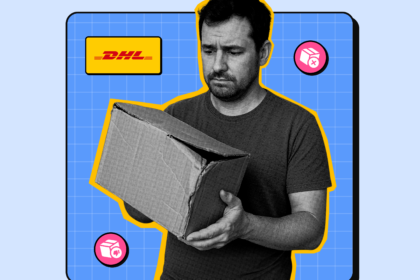Nothing affects a customer’s trust more than receiving a damaged package at their doorstep. It frustrates the customer but is even more harmful for the e-commerce business: damaged reputation, negative reviews, and customers who might never order again.
And let’s not forget the costs of covering lost merchandise, extra labor, and product replacement or discounts. In the U.S. alone, shipping damage results in about $1 billion in losses annually. So, the last thing you want is to lose money on refunds and replacements when most of this damage is 100% preventable.
When shipping fragile items is a part of your grind, it’s time to rethink your approach and make extra efforts to ensure that products reach customers safely without any damage.
Understanding Fragile Items
Fragile items are any product or material that is damaged easily, even from a low-force impact. These can include glassware, ceramics, or crystals that can break easily or perishables, electronics, furniture, or luxury goods that can be chipped, scratched, or torn during transit.
In short, almost any item can get damaged during shipping, requiring special handling to ensure protection.
Choosing the Right Packaging Materials
The guide to preventing damage to your fragile items begins with packaging — at your warehouse. Think of packaging as the first line of defense. If this works out perfectly, then the chances of breakage are cut down to half or even much lower.
And it all starts with choosing the right packaging material suited for shipping fragile items based on their size, shape, and delivery requirements.
- Cushioning materials: Cushioning packaging with air-filled polyethylene film, such as air pillows, offers overall impact protection for industrial packaging. It stays inflated and provides better cushioning for fragile items throughout the shipping cycle.
- Foam sheets: Foam packing sheets made from recycled closed-cell polyethylene foam are a flexible and lightweight packaging material to prevent delicate items from slipping.
- Protective bubble wrap: Bubble wrap is created using two solid layers of low-density polyethylene, making it abrasion-resistant and shock-proof. Plus, it is effective even with multiple uses, so it is ideal for shipping fragile items.
- Fragile packing tape: Use heavy-duty packaging tape labeled ‘fragile’ to secure all the edges of the box firmly and also alert shippers about the fragile items for maximum security.
Packing Fragile Items Step-by-Step
Packaging fragile items should be a careful process to ensure the product is secure during shipping. Here’s what it involves-
A. Choose the right box size
While shipping fragile items, you need a sturdy, heavy, and corrugated box that is thick enough to protect the item. At the same time, pick the right box size – it should be slightly larger than your product to accommodate ample cushioning but not so big that the content shifts around even with sufficient padding.
B. Pack the item in cushioning material
Make appropriate use of packaging material like foam sheets, air pillows, and bubble wraps to secure all the items in the package. But this does not mean you can pack every product in the same way. Different items require different care.
For instance, shipping glassware or ceramics requires durable cushioning material like a bubble wrap as well as multiple layers of packaging, while high-value breakables need moulded infills to protect them from damage. Similarly, hollow products like glass vases or mugs should also have infills to avoid any empty space in the package.
Then, reinforce the cushioning around the product by packing peanuts or crumpled paper to prevent movement within the box.
C. Don’t overload
Overloading the box is a common issue that can lead to damaged deliveries. While it is a sustainable solution, it’s not always the answer.
Sure, if your package contains multiple items, use custom inserts for dividers or wrap each item individually — but pay particular attention to corners and edges so that the box doesn’t break apart during transit. Overloading the box past its carrying capacity could also make it challenging to add enough padding for all products, further increasing the chances of damage.
D. Secure the bottom of the box
No matter how securely you pack the items, if the bottom of the box is not protected properly, it’s prone to damage. While filling up empty spaces with cushioning material, don’t forget to leave enough padding at the bottom.
Ensure the box is sturdy, with extra layers of tape at the bottom seams and corners for extra safety. Adding enough layers of packing peanuts at the bottom is a good idea.
E. Label your box clearly
Damages are mostly accidents, sometimes due to man-made incidents, although unintentional. Workers at carrier sorting facilities deal with a huge volume of shipments on a day-to-day basis.
So, mishandling is a common occurrence that can be less of a concern for a retailer who sells teddy bears. But as someone shipping out fragile items, you can’t afford these chances. This is where you bring in clear and informative labeling.
Labels that say “Fragile” and “Handle with Care” are your product’s advocates. These labels let the handlers know of the contents and ensure your package(s) are treated with extra care.
Selecting a Shipping Carrier
Major carriers such as FedEx, UPS, DHL, and USPS all have their list of suggestions and deadlines for retailers shipping fragile items.
- FedEx: For fairly new merchants, FedEx provides the option to purchase standard and specialized boxes based on the item and charges an extra amount for packaging fragile items.
- UPS: Similar to FedEx, UPS also helps merchants with packaging fragile items such as lamps, furniture, pianos, artwork, mirrors, and vases.
- DHL: Apart from guidelines, DHL also offers shippers options such as faster delivery options, special handling, and shipping insurance, all of which are charged an additional fee.
- USPS: Unlike other carriers, USPS has a particular service for shipping fragile items called Special Handling-Fragile that can be availed at $12.15 and works with multiple USPS services, including Priority Mail Express, Priority Mail, First-Class Package Service-Commercial, and more.
Tips for Extra Protection
When shipping fragile items, a little extra precaution can go a long way to ensure secure handling. This is because even with a reliable carrier, packages go through multiple handling points where the chances of product damage increase.
As a result, following the right packing techniques can be the difference between a safe delivery and a disappointing customer experience. Here are a few tips for extra protection of your shipments:
- Try double boxing: For high-value delicate items, consider double boxing. A smaller inner box packed tightly with cushioning material and a bigger outer box will reduce the risk of damage during transit.
- Use loose fill: Stuff the packaging boxes with loose fill to fill any space and ensure extra security for the fragile items.
- Box heavy items separately: If your package contains any heavy items, box them individually to avoid damaging any of the smaller items with them.
- Ensure the items are intact: Secure the product firmly within the box to prevent any movement through bubble wrap, foam, air pillows, etc.
- Multi-layer packing: For exceptionally fragile items like glassware, consider multiple layers of packaging
Common Mistakes to Avoid
Packaging fragile items requires meticulous attention to detail – from using shock-absorbent materials to picking sturdy boxes. But sometimes, it’s not about what you did but what you didn’t do that can cause unnecessary damage to the shipping.
So, to ensure the shipments are delivered safely, watch out for these common mistakes:
1. Insufficient cushioning
Skimping on protective padding is a no-go. Shipping fragile items requires more than just a thin layer of bubble wrap or packing peanuts at the bottom. Ideally, pack each item with at least two inches of cushioning material.
2. Relying on fragile labels alone
Couriers handle thousands of packages a day, and relying only on fragile labeling to protect the package isn’t the best idea. Proper packaging with cushioning material and sturdy boxes is your real protection.
3. Packing too tightly
When you want to ensure that the items don’t move around in the package easily, you might end up packing the product too tightly. However, compression can be just as damaging as impact, and the product can break easily if it hits a surface.
4. Poor storage
This is an often overlooked aspect of shipping fragile items. Exposing delicate items to poor storage and handling conditions such as dust, humidity, temperature, or pests can affect the quality of the items. For instance, using waterproof packaging material in heavy-rain areas will ensure the product is protected from breakage or deterioration.
5. Not getting insurance
Insuring the goods can be pricey, but a high-value, uninsured item getting damaged can be much worse for the business finances. So, it’s better to get insurance for heavy and costly goods to get some peace of mind – the insurance company will cover the losses if the box is damaged or lost during shipping.
Conclusion
As a frequent shipper of fragile items, following these steps might be extremely handy to minimize the chances of damage.
However, damage, like all delivery issues, is inevitable, even with the best of the packaging carriers. In such cases, proactive customer communication is your best option. Be empathetic about the incident and offer a solution to mitigate their frustration.
Even if damaged shipments cannot be avoided, you still have a shot at redemption. Shipping carriers offer retailers the option to claim refunds for shipments damaged in transit. Instead of filing these claims manually, you can rely on a parcel audit solution that automates the process.
With a shipping protection and parcel audit solution like LateShipment, you don’t have to leave things to chance. Our Shipment Protection software offers comprehensive risk coverage if your fragile package is lost or damaged in transit. Not to mention, unlike traditional carrier insurance, we make the claims process hassle-free by centralizing claims management.
You can easily file claims within seconds—select the shipment, upload proof, and let automation handle everything for you. Tracking claims is even simpler, thanks to a unified dashboard, so you can focus on your business instead of chasing reimbursements.
But that’s not all. Shipping costs can add up fast, especially when carriers fail to meet their promised service levels. Our Parcel and Shipping Invoice Audit Solution helps you report loss or damage, manage claims documentation, and automate refund claims for lost/damaged packages. That means fewer losses, optimized costs, and a better shipping experience for your customers.
Running an e-commerce business is challenging enough—let LateShipment take the stress out of shipping. Protect your packages, recover lost dollars, and deliver a better experience.







